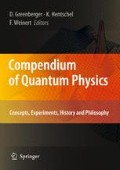The GHZ states (Greenberger—Horne—Zeilinger states) are a set of entangled states that can be used to prove the GHZ theorem, which is a significant improvement over ► Bell's Theorem as a way to disprove the concept of “elements of reality”, a concept introduced by ► EPR problem (Einstein—Podolsky—Rosen) in their attempt to prove that quantum theory is incomplete. Conceding that they did not quite know what “reality” is, EPR nonetheless said that it had to contain an “element of reality” as one of its properties. This was that if one could discover a property of a system (i.e., predict it with 100% certainty) by making an experiment elsewhere, that in no way interacted with the system, then this property was an element of reality. The argument was that since one had not in any way interacted with the system, then one could not have affected this property, and so the property must have existed before one performed one's experiment. Thus the property is an intrinsic part of the system, and not an artifact of the measurement one made.
From a common-sense point of view, this proposition seems unassailable, and yet quantum theory denies it. For example, in the Bohm form of the EPR experiment, one has a particle that decays into two, that go off in opposite directions. If the original particle had ► spin 0, while each of the two daughters has spin 1/2, then if the one going to the right has its spin up, the one going to the left will have its spin down, and vice-versa. So the spin of each of the daughters is an element of reality, because if one measures the spin of the particle on the right as up, one can predict with 100% certainty that the other will be spin down, etc. EPR would conclude from this that, since we did not interfere with the particle on the left in any way, then we could not have changed its spin, and so it had to have been spin down from the moment the original particle decayed.
Access this chapter
Tax calculation will be finalised at checkout
Purchases are for personal use only
Preview
Unable to display preview. Download preview PDF.
Literature
The EPR argument was first made by
A. Einstein, B. Podolsky, N. Rosen: Can Quantum-Mechanical Description of Physical Reality Be Considered Complete? Phys. Rev. 47, 777–780 (1935) Bohr's answer was given in
N. Bohr: Can Quantum-Mechanical Description of Physical Reality be Considered Complete? Phys. Rev. 48, 696–702 (1935) Bell's Theorem was first stated in
J. S. Bell: On the Einstein-Podolsky-Rosen Paradox. Physics 1, 195–200 (1964)
These and many other papers relevant to the discussion, up to 1982, are contained in the book
J. A. Wheeler, W. H. Zurek (eds.): Quantum Theory and Measurement (Princeton University Press, Princeton 1983) All John Bell's papers relevant to the discussion are contained in the book
J. S. Bell: Speakable and Unspeakable in Quantum Mechanics (Cambridge University Press, Cambridge 1987). They are also included in the book M. Bell, K. Gottfried, M. Veltman (eds.): John S. Bell on the Foundations of Quantum Mechanics (World Scientific, Singapore 2001). GHZ states were first introduced in a very short paper by
D. M. Greenberger, M. A. Horne, A. Zeilinger in M. Kafatos (ed.): Bell's Theorem, Quantum Theory, and Conceptions of the Universe (Kluwer, Dordrecht 1989, 73–76). An expanded, and much more complete version is given in D. M. Greenberger, M. A. Horne, A. Zeilinger, A. Shimony: Bell's Theorem without Inequalities. Am. J. Phys. 58, 1131–43 (1990)
The Mermin experiment we discuss was first described by
D. Mermin, Physics Today 43/6, 9 (June 1990); Quantum Mysteries Revisited. Am. J. Phys. 58, 731–34 (1990). See also Asher Peres: Quantum Theory: Concepts and Methods (Kluwer, Dordrecht, the Netherlands 1995) The Mermin experiment has been essentially performed with a multi-photon system by
J.-W. Pan, D. Bouwmeester, M. Daniell, H. Weinfurter, A. Zeilinger: Experimental Test of quantum nonlocality in three-photon Greenberger—Horne—Zeilinger entanglement. Nature 403, 515–9 (2000). See also the review by J.-W. Pan and A. Zeilinger, in R. A. Bertlmann, A. Zeilinger (eds.): Quantum (Un)speakables — From Bell to Quantum Information (Springer, Berlin 2002, 225–240).
Editor information
Editors and Affiliations
Rights and permissions
Copyright information
© 2009 Springer-Verlag Berlin Heidelberg
About this chapter
Cite this chapter
Greenberger, D.M. (2009). GHZ (Greenberger—Horne—Zeilinger) Theorem and GHZ States. In: Greenberger, D., Hentschel, K., Weinert, F. (eds) Compendium of Quantum Physics. Springer, Berlin, Heidelberg. https://doi.org/10.1007/978-3-540-70626-7_78
Download citation
DOI: https://doi.org/10.1007/978-3-540-70626-7_78
Published:
Publisher Name: Springer, Berlin, Heidelberg
Print ISBN: 978-3-540-70622-9
Online ISBN: 978-3-540-70626-7
eBook Packages: Physics and AstronomyPhysics and Astronomy (R0)

